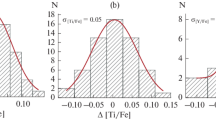Abstract
GALACTIC globular clusters were once thought to be chemically homogeneous, having formed quite rapidly from relatively small condensations of primordial gas29. In many clusters, significant star-to-star variations in light-element abundances have been observed1–4 in evolved giant stars. These variations have been attributed to the presence at the stellar surfaces of nucleosynthesis products generated deep within the stars. But other observations13 have suggested that some of this variability was established earlier in the stars' lifetimes, perhaps as a result of inhomogeneities in the gas cloud from which the cluster formed. Here we report the observation of variations in the sodium abundances of unevolved (main-sequence) stars in the cluster 47 Tucanae. Although these variations are similar to those observed in evolved cluster stars, they cannot be explained by mixing, in the framework of current models of stellar evolution. This indicates either that the gas out of which 47 Tuc formed was chemically inhomogeneous, or that some mechanism for altering the surface element abundances of stars operates while they are still on the main sequence.
Similar content being viewed by others
References
Smith, G. H. Publ. Astron. Soc. Pacif. 99, 67–90 (1987).
Suntzeff, N. B. in The Globular Cluster-Galaxy Connection (eds Smith, G. H. & Brodie, J. P.) 167–179 (ASP Conf. Ser. Vol. 48, Astronomical Society of the Pacific, San Francisco, 1993).
Briley, M. M., Bell, R. A., Hesser, J. E. & Smith, G. H. Can. J. Phys. 72, 772–781 (1994).
Kraft, R. P. Publ. Astron. Soc. Pacif. 106, 553–565 (1994).
Norris, J. & Freeman, K. C. Astrophys. J. 230, L179–L182 (1979).
Cottrell, P. L. & Da Costa, G. S. Astrophys. J. 245, L79–L82 (1981).
Gratton, R. L., Quarta, M. L. & Ortolani, S. Astron. Astrophys. 169, 208–218 (1986).
Brown, J. A. & Wallerstein, G. Astron. J. 104, 1818–1830 (1992).
Langer, G. E. & Hoffman, R. Publ. Astron. Soc. Pacif. 107, 1177–1182 (1995).
Cavallo, R. M., Sweigart, A. V. & Bell, R. A. Astrophys. J. 464, L79–L82 (1996).
Sweigart, A. V. & Mengel, J. G. Astrophys. J. 229, 624–641 (1979).
Charbonnel, C. Astron. Astrophys. 282, 811–828 (1994).
Briley, M. M., Hesser, J. E., Bell, R. A., Bolte, M. & Smith, G. H. Astron. J. 108, 2183–2192 (1994).
Cayrell, R. in The Impact of Very High Signal to Noise Spectroscopy on Stellar Physics (eds Cayrell de Strobel, G. & Spite, M.) 345–353 (Kluwer, Dordrecht, Boston, 1988).
Sneden, C. Astrophys. J. 184, 839–849 (1973).
Norris, J. & Freeman, K. C. Astrophys. J. 230, L179–L182 (1979).
Bell, R. A., Dickens, R. J. & Gustafsson, B. Astrophys. J. 229, 604–623 (1979).
Carbon, D. F. et al. Astrophys. J. Suppl. Ser. 49, 207–258 (1982).
Trefzger, D. V., Langer, G. E., Carbon, D. F., Suntzeff, N. B. & Kraft, R. P. Astrophys. J. 266, 144–159 (1983).
Sneden, C., Kraft, R. P., Prosser, C. F. & Langer, G. E. Astron. J. 104, 2121–2140 (1992).
Kraft, R. P., Sneden, C., Langer, G. E. & Shetrone, M. D. Astron. J. 106, 1490–1507 (1993).
Pilachowski, C. A., Sneden, C., Kraft, R. P. & Langer, G. E. Astron. J. 112, 545–564 (1996).
Bell, R. A. & Dickens, R. J. Astrophys. J. 242, 657–672 (1980).
Suntzeff, N. B. & Smith, V. V. Astrophys. J. 381, 160–172 (1991).
Briley, M. M., Smith, V. V. & Lambert, D. L. Astrophys. J. 424, L119–L122 (1994).
Hesser, J. E., Shott, P., Harris, W. E., Allwright, J. W. B. & VandenBerg, D. A. Publ. Astron. Soc. Pacif. 99, 739–808 (1987).
Pilachowski, C. A., Sneden, C. & Kraft, R. P. Astron. J. 111, 1689–1704 (1996).
Norris, J. E. & Da Costa, C. S. Astrophys. J. 447, 680–705 (1995).
Murray, S. D. & Lin, D. N. Astrophys. J. 339, 933–942 (1989).
Author information
Authors and Affiliations
Rights and permissions
About this article
Cite this article
Briley, M., Smith, V., Suntzeff, N. et al. Sodium abundance variations in main-sequence stars of the globular cluster 47 Tucanae. Nature 383, 604–606 (1996). https://doi.org/10.1038/383604a0
Received:
Accepted:
Issue Date:
DOI: https://doi.org/10.1038/383604a0
- Springer Nature Limited
This article is cited by
-
Multiple populations in globular clusters
The Astronomy and Astrophysics Review (2012)





